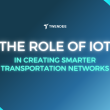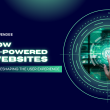The Internet of Things (IoT) is transforming transportation by integrating real-time data and advanced analytics into vehicles, infrastructure, and systems. This technology creates smarter networks that are more efficient, safer, and aligned with sustainability goals. In this blog, we will explore how IoT enhances transportation, showcases its applications across diverse industries, and addresses the challenges of its implementation.
Understanding IoT in Transportation
IoT in transportation integrates sensors, devices, and systems to gather and analyze real-time data. These technologies enable dynamic adjustments to traffic flows, fleet management, and logistics operations, resulting in seamless mobility and efficiency. For example, smart traffic lights powered by IoT dynamically adapt to congestion levels, reducing delays. A report by Juniper Research highlights IoT’s potential, estimating that smart traffic systems can cut traffic delays by over 15% in major cities, showcasing its ability to enhance urban mobility.
To explore how IoT supports connected vehicle technology and the future of transportation, read more in our detailed blog.
Why IoT Fleet Management Matters in Transportation
Fleet management has always been critical for businesses reliant on transportation. IoT adds a new dimension by enabling companies to monitor vehicles in real time, optimize routes, and predict maintenance needs using interconnected sensors and devices.
The Numbers Speak:
- McKinsey & Company estimates that IoT applications in fleet management could lead to a 15–25% reduction in logistics costs.
- IoT-enabled fleet management tools increase fleet utilization rates by 10–15%, as shown in industry-wide surveys.
By leveraging IoT, companies can ensure their fleets operate with maximum efficiency while minimizing unexpected disruptions.
How IoT Creates Smarter Transportation Networks
Real-Time Data as the Backbone
IoT thrives on real-time data. Sensors installed in vehicles, infrastructure, and devices continuously collect information about traffic conditions, vehicle health, and environmental factors. For example, during peak traffic hours, IoT-enabled navigation systems can reroute vehicles to avoid congestion, minimizing delays and fuel consumption.
Optimizing Traffic Management
IoT enhances traffic management by analyzing live data and making adjustments on the go. Cities implementing smart traffic lights and adaptive systems report smoother vehicle flow and significant reductions in idling-related emissions. These systems not only improve commuter experiences but also contribute to cleaner air and lower carbon footprints.
Fleet Management Revolution
For fleet operators, IoT delivers real-time visibility into operations. Predictive maintenance tools monitor vehicle health, reducing the likelihood of costly breakdowns. Additionally, IoT allows for dynamic route optimization, helping fleets save fuel and meet delivery deadlines more effectively. Studies show that IoT-enabled fleets experience up to 20% cost savings, demonstrating its economic benefits.
Driving Sustainability
IoT supports sustainability by reducing waste and emissions. For example, optimized routing minimizes fuel consumption, while smart charging infrastructure facilitates the integration of electric vehicles. IoT also enables emissions monitoring, helping businesses and cities meet regulatory standards and environmental goals.
Enhancing Safety
IoT improves safety across transportation networks through real-time monitoring and alerts. Sensors detect hazards such as icy roads or dangerous driving behaviors and notify drivers and managers immediately. This proactive approach helps prevent accidents and enhances road safety.
IoT Applications Across Industries: Real Use Cases
Logistics and Supply Chain Management
In the logistics industry, maintaining the integrity of sensitive goods is critical. IoT solutions, like Maersk’s use of sensors in shipping containers, ensure temperature and humidity are carefully monitored throughout transit. This system reduced spoilage by 30% in pilot programs, demonstrating the tangible benefits of IoT in logistics.
Public Transportation
Public transportation systems benefit greatly from IoT, especially with features like real-time updates and predictive analytics. Singapore’s IoT-driven public transit system tackles common challenges like wait times and overcrowding. By providing real-time updates and allocating resources dynamically, the system not only improves commuter satisfaction but also enhances operational efficiency for transit providers. The result? A 25% drop in commuter complaints and better resource management for transit operators.
Automotive Industry
The automotive sector relies heavily on IoT for connected and autonomous vehicle technologies. From Tesla’s over-the-air updates improving vehicle efficiency to Barcelona’s IoT-enabled parking sensors reducing congestion, IoT demonstrates its adaptability across industries. This technology enhances user experience while reducing the need for service center visits.
Agriculture and Cold Chain Logistics
IoT is pivotal in cold chain logistics, particularly for transporting temperature-sensitive goods. Companies like Carrier Transicold use IoT to monitor and control refrigerated containers, ensuring compliance with food safety regulations. This approach reduces spoilage and waste, increasing supply chain efficiency.
Smart Cities
IoT is a cornerstone of smart city initiatives, such as Barcelona’s smart parking system. Sensors installed in parking spaces inform drivers of available spots through a mobile app, reducing the time spent searching for parking. This solution has cut traffic congestion and improved air quality, benefiting both commuters and the environment.
Challenges of IoT Implementation
While IoT offers transformative benefits, its implementation is not without challenges:
- High Infrastructure Costs: Upgrading legacy systems to support IoT requires significant investment.
- Data Privacy Concerns: IoT networks handle sensitive data, necessitating robust security measures to prevent breaches.
- Integration Complexities: Ensuring seamless compatibility with existing platforms can be resource-intensive.
Addressing these challenges requires strategic planning, stakeholder collaboration, and a focus on long-term value.
IoT is a transformative force in transportation, enabling smarter, more adaptive systems that enhance efficiency, safety, and sustainability. From logistics to public transit and smart cities, its applications highlight the power of connectivity in solving modern mobility challenges. By investing in IoT today, businesses and cities can position themselves as leaders in innovation, shaping a more connected future.
At Twendee Software, we focus on creating practical IoT solutions that address the unique challenges of modern transportation. Whether it’s optimizing fleet operations, enabling predictive analytics, or integrating sustainable technologies, we tailor our offerings to your specific needs. By combining industry expertise with innovative approaches, we help businesses and cities unlock the full potential of smarter, more efficient transportation systems.
Let’s work together to shape the future of transportation!










What do you think?